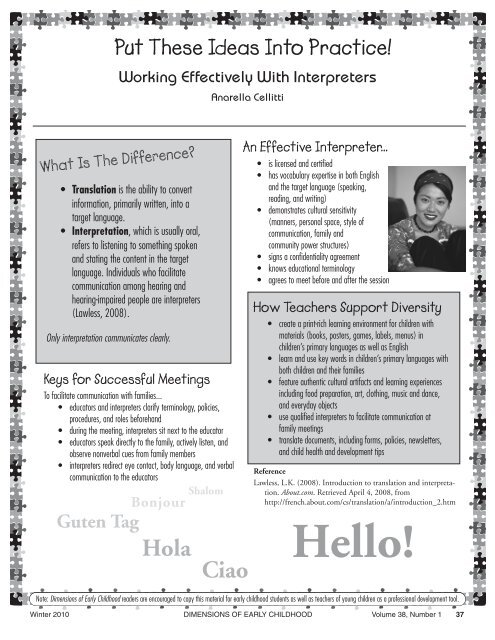90223 Dimensions Winter 10:Layout 1 - Southern Early Childhood ...
90223 Dimensions Winter 10:Layout 1 - Southern Early Childhood ...
90223 Dimensions Winter 10:Layout 1 - Southern Early Childhood ...
Create successful ePaper yourself
Turn your PDF publications into a flip-book with our unique Google optimized e-Paper software.
Put These Ideas Into Practice!<br />
Working Effectively With Interpreters<br />
Anarella Cellitti<br />
• Translation is the ability to convert<br />
information, primarily written, into a<br />
target language.<br />
• Interpretation, which is usually oral,<br />
refers to listening to something spoken<br />
and stating the content in the target<br />
language. Individuals who facilitate<br />
communication among hearing and<br />
hearing-impaired people are interpreters<br />
(Lawless, 2008).<br />
Only interpretation communicates clearly.<br />
Keys for Successful Meetings<br />
To facilitate communication with families...<br />
• educators and interpreters clarify terminology, policies,<br />
procedures, and roles beforehand<br />
• during the meeting, interpreters sit next to the educator<br />
• educators speak directly to the family, actively listen, and<br />
observe nonverbal cues from family members<br />
• interpreters redirect eye contact, body language, and verbal<br />
communication to the educators<br />
Shalom<br />
Guten Tag<br />
Bonjour<br />
Hola<br />
Ciao<br />
An Effective Interpreter...<br />
• is licensed and certified<br />
• has vocabulary expertise in both English<br />
and the target language (speaking,<br />
reading, and writing)<br />
• demonstrates cultural sensitivity<br />
(manners, personal space, style of<br />
communication, family and<br />
community power structures)<br />
• signs a confidentiality agreement<br />
• knows educational terminology<br />
• agrees to meet before and after the session<br />
How Teachers Support Diversity<br />
• create a print-rich learning environment for children with<br />
materials (books, posters, games, labels, menus) in<br />
children’s primary languages as well as English<br />
• learn and use key words in children’s primary languages with<br />
both children and their families<br />
• feature authentic cultural artifacts and learning experiences<br />
including food preparation, art, clothing, music and dance,<br />
and everyday objects<br />
• use qualified interpreters to facilitate communication at<br />
family meetings<br />
• translate documents, including forms, policies, newsletters,<br />
and child health and development tips<br />
Reference<br />
Lawless, L.K. (2008). Introduction to translation and interpretation.<br />
About.com. Retrieved April 4, 2008, from<br />
http://french.about.com/cs/translation/a/introduction_2.htm<br />
Hello!<br />
Note: <strong>Dimensions</strong> of <strong>Early</strong> <strong>Childhood</strong> readers are encouraged to copy this material for early childhood students as well as teachers of young children as a professional development tool.<br />
<strong>Winter</strong> 20<strong>10</strong> DIMENSIONS OF EARLY CHILDHOOD Volume 38, Number 1 37
















